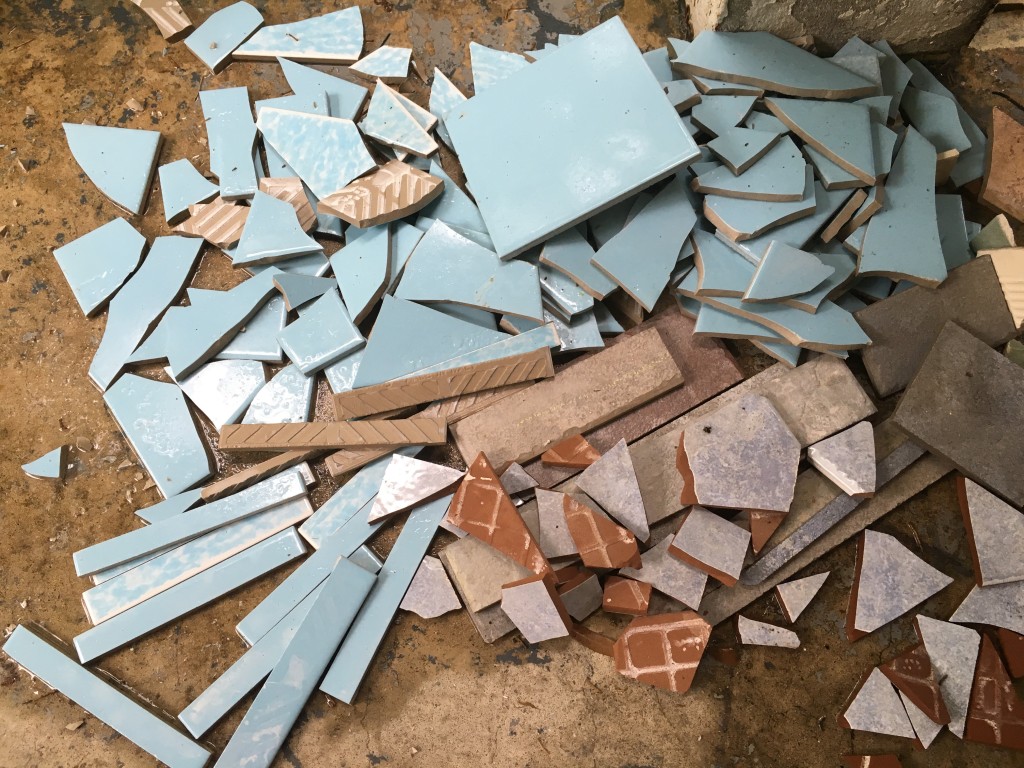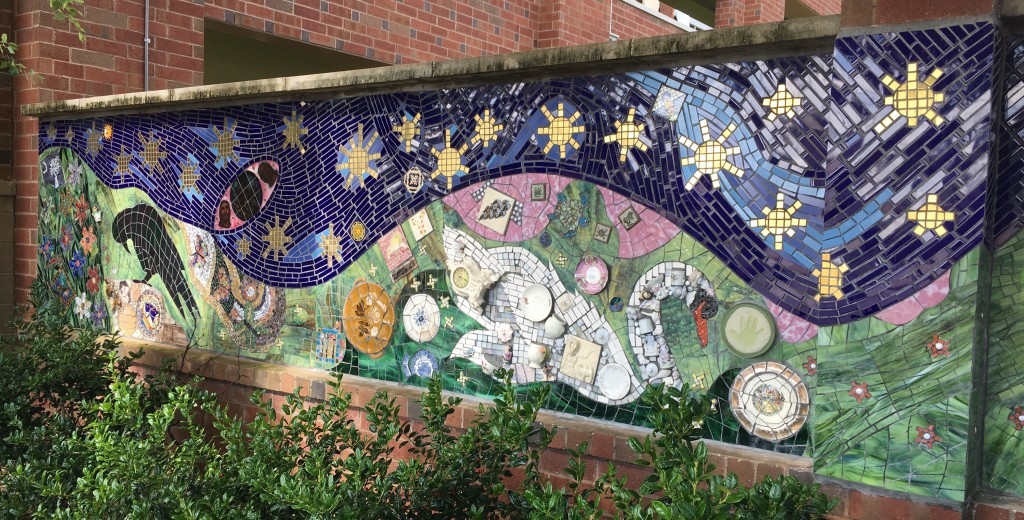It was nearing 10:00 pm when I looked up from my project. I had no idea it was that late. Darkness had fallen. I hadn’t eaten dinner. My water glass was long emptied. The cats were roaming, but where? As I stood up from my short stool, I was stiff from being in the same position for…well, I really don’t know how long.
For over a decade, I’ve wanted to create a tile mosaic on the floor of my front porch. It’s a big porch. Turning my desire into reality has taken a few years, but I finally started. Most of the day was spent in service of different aspects of the project—collecting more tile, replacing the tile saw blade, cleaning the floor. But by late afternoon, I was back in business on the porch. While a wet tile saw is not the most dangerous of power tools, using it alone at home requires additional attention. Long straight cuts and multiple short runs to transform a 12” x 12” tile into 1” x 1” pieces is a bit mundane for my typically busy mind. But I was determined to not have any accidents or injuries and remained vigilant, catching myself when I found my mind drifting.

After quite some time on the saw, I switched to the hammer. Methodically shattering tile over and over creates a fascinating melody. The organic shapes this method creates make a more interesting mosaic. I was watching for unique forms, nice curves, sloping lines. Imagining them in the greater gestalt. I was completely immersed in what I was doing.
 Do you ever become completely immersed in something? Do you ever lose all sense of time, external distractions, internal cues or concerns while engaged in an activity? If you do, it’s known as “flow”—also known as being “in the zone”, “in the groove”, or completely absorbed.
Do you ever become completely immersed in something? Do you ever lose all sense of time, external distractions, internal cues or concerns while engaged in an activity? If you do, it’s known as “flow”—also known as being “in the zone”, “in the groove”, or completely absorbed.
Hungarian-born, University of Chicago-educated psychologist, Mihaly Csikszentmihalyi (chick-sent-mee-high) (www.pursuit-of-happiness.org) was originally researching happiness and creativity when he began to recognize what he labeled “flow” as a state of consciousness in which there are distinct elements involved in the experience:
- The activity is intrinsically rewarding
- There are clear goals (both short term and long term)
- There is immediate feedback for one’s actions
- There is a balance between challenge and ability
- Action and awareness merge
- Distractions are excluded from consciousness
- There is no worry of failure
- Self-consciousness disappears
- The sense of time becomes distorted
 Csikszentmihalyi conceptualizes flow as the opposite of apathy and theorizes that it lies between a state of tension (anxiety) and a state of relaxation. He believes that it is a state of action, which is in contrast with Eastern thinking which would posit that it is a state of inaction or a relaxed state of being. Most now agree that flow can be achieved whether one is engaged in a challenging sport (skiing, tennis, rock climbing), a creative endeavor (painting, playing music, cooking), or even something as passive as reading or eating. Have you ever watched a guitarist “noodling”? The expression on their face (or lack thereof) might indicate that they have entered the altered state of flow.
Csikszentmihalyi conceptualizes flow as the opposite of apathy and theorizes that it lies between a state of tension (anxiety) and a state of relaxation. He believes that it is a state of action, which is in contrast with Eastern thinking which would posit that it is a state of inaction or a relaxed state of being. Most now agree that flow can be achieved whether one is engaged in a challenging sport (skiing, tennis, rock climbing), a creative endeavor (painting, playing music, cooking), or even something as passive as reading or eating. Have you ever watched a guitarist “noodling”? The expression on their face (or lack thereof) might indicate that they have entered the altered state of flow.
The focus and intense concentration required to enter a state of flow are what mark it as a peak experience, a concept that Abraham Maslow (remember the Hierarchy of Needs and Self-Actualization?) was researching in the 1960’s. He suggested that a peak experience happened at times of intensely focused concentration and was a moment of a euphoric mental state that contributed to our overall sense of serenity and well-being. In other words, a moment of happiness.
The emotional reaction in the peak experience has a special flavor of wonder, of awe, of reverence, of humility, and surrender before the experience as before something great. –Abraham Maslow
Contrary to how we generally use the word ‘happy’, it is not a steady on-going state, but rather short periods of time that we string together. Someone who is ‘happy’ still has fluctuations in experiences and moods; for example, I may be a happy person but I still have daily stressors, aggravations, sad moments, irritable times, and even anger. “Happiness” is then recognized as a short term state or, more accurately, a peak experience in a daily life of varying experiences.
“Happiness” is then recognized as a short term state or, more accurately, a peak experience in a daily life of varying experiences. Click To TweetIn the pursuit of the marvelous amidst the messiness of life, do you have something which is so completely absorbing that you can get lost? Something that is so captivating that you transcend your circumstances and your worries? Something that leaves you feeling satisfied afterwards? Those are the moments that contribute to our overall sense of happiness. Last night, at 10 pm, I was happy. Sore, but happy.
So Immerse Yourself , because moments of flow make this messy life more marvelous.
Rhea
The beautifully creative mosaic above is only about 1/2 of a larger mural on a brick fence in downtown Columbia, SC.

